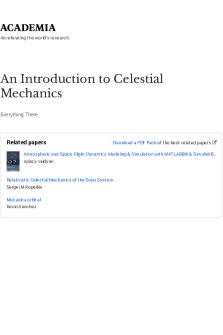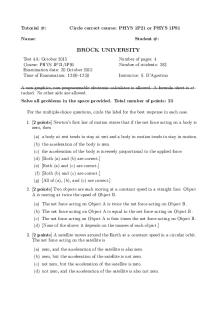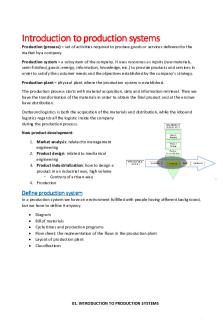01. Introduction to continuum mechanics applied to living and inert solids PDF

| Title | 01. Introduction to continuum mechanics applied to living and inert solids |
|---|---|
| Author | Miriam PM |
| Course | Mecánica de Solidos |
| Institution | Universidad Carlos III de Madrid |
| Pages | 17 |
| File Size | 675.9 KB |
| File Type | |
| Total Downloads | 81 |
| Total Views | 138 |
Summary
01. Introduction...
Description
Theme 1. Introduction to continuum mechanics applied to living and inert solids
CONTINUUM BIOMECHANICS I Academic Year 2017/18
Theme 1
Introduction to continuum mechanics applied to living and inert solids J. A. Rodríguez-Martínez Department of Continuum Mechanics and Structural Analysis
Theme 1. Introduction to continuum mechanics applied to living and inert solids
INDEX
• • • •
Objectives Continuum theory Continuum mechanics Continuum biomechanics
Theme 1. Introduction to continuum mechanics applied to living and inert solids
INDEX
• • • •
Objectives Continuum theory Continuum mechanics Continuum biomechanics
Theme 1. Introduction to continuum mechanics applied to living and inert solids
OBJECTIVES
Relying on the continuum theory the continuum biomechanics framework is developed
Theme 1. Introduction to continuum mechanics applied to living and inert solids
INDEX
• • • •
Objectives Continuum theory Continuum mechanics Continuum biomechanics
Theme 1. Introduction to continuum mechanics applied to living and inert solids
INDEX
• • • •
Objectives Continuum theory Continuum mechanics Continuum biomechanics
Theme 1. Introduction to continuum mechanics applied to living and inert solids
Continuum theory Matter is composed of discrete units called molecules, which consist of atoms and subatomic particles … Thus matter is not continuous
In principle, we could describe the macroscopic behaviour of materials based on detailed knowledge of the microscopic behaviour using statistical mechanics,
though even the simplest of problems can be mathematically intractable
Theme 1. Introduction to continuum mechanics applied to living and inert solids
Continuum theory However, and fortunately, many aspects of daily life can be described or
predicted with theories that pay no attention to the molecular structure of materials (e. g., bone deformation, blood flow)
Continuum theory describes relationships between phenomena by paying no attention to the molecular structure of materials
It regards matter as indefinitely divisible, an assumption that is justified only so far as it can adequately capture experimental observations
Theme 1. Introduction to continuum mechanics applied to living and inert solids
INDEX
• • • •
Objectives Continuum theory Continuum mechanics Continuum biomechanics
Theme 1. Introduction to continuum mechanics applied to living and inert solids
INDEX
• • • •
Objectives Continuum theory Continuum mechanics Continuum biomechanics
Theme 1. Introduction to continuum mechanics applied to living and inert solids
Continuum mechanics Mechanics is the branch of physics relating applied forces to motion Continuum mechanics studies the response of materials, both solids and fluids, at the macroscopic level when subjected to different loading conditions
While rigid body motion is included in this theory as a special reduction,
deformation of materials under applied loads is its most important common application The subject of continuum mechanics can be subdivided into two primary parts:
general principles (i. e. governing equations) and constitutive relationships
Theme 1. Introduction to continuum mechanics applied to living and inert solids
Continuum mechanics General principles
General principles are common to all materials (e. g. conservation of mass and energy, principle of linear momentum and angular momentum, principle of entropy)
These governing equations can take two different, yet equivalent, forms One is an integral formulation over a finite volume
The second is field equation for a particle or differential material volume at every point
Theme 1. Introduction to continuum mechanics applied to living and inert solids
Continuum mechanics Constitutive relationships
Constitutive relationships are equations defining idealized materials. Some examples are an elastic body (deformation → 0 as load → 0), linearly elastic solid (stress linearly related to strain), and linearly viscous luid (stress linearly related to strain rate)
In general, constitutive equations vary from material to material and, for a given material, may vary depending on the loading conditions
Theme 1. Introduction to continuum mechanics applied to living and inert solids
Continuum mechanics The elegance of continuum mechanics is its mathematical framework that yields concise treatment of the governing equations and constitutive relationships
In continuum mechanics two aspects of investigation can be considered One is the formulation of constitutive equations appropriate for describing behaviours of particular classes of materials under certain loading conditions The second is solving the governing equations, in combination with the constitutive equations under circumstances of interest to scientist and engineers
Theme 1. Introduction to continuum mechanics applied to living and inert solids
INDEX
• • • •
Objectives Continuum theory Continuum mechanics Continuum biomechanics
Theme 1. Introduction to continuum mechanics applied to living and inert solids
INDEX
• • • •
Objectives Continuum theory Continuum mechanics Continuum biomechanics
Theme 1. Introduction to continuum mechanics applied to living and inert solids
Continuum biomechanics Biomechanics is the application of engineering mechanics to biological systems
It is important to keep in mind that the majority of equations
and problem solving techniques that will be studied in this course are applicable to a large range of engineering materials and not just to human locomotion or to tissues and cells within the body...
Similar Free PDFs

Introduction to Fluid Mechanics
- 321 Pages

01 Introduction to Management
- 18 Pages

Module 1 Introduction To Mechanics
- 11 Pages

An Introduction to Celestial Mechanics
- 217 Pages

Chapter 01 - Introduction to Android
- 34 Pages

Continuum Mechanics Notes
- 123 Pages
Popular Institutions
- Tinajero National High School - Annex
- Politeknik Caltex Riau
- Yokohama City University
- SGT University
- University of Al-Qadisiyah
- Divine Word College of Vigan
- Techniek College Rotterdam
- Universidade de Santiago
- Universiti Teknologi MARA Cawangan Johor Kampus Pasir Gudang
- Poltekkes Kemenkes Yogyakarta
- Baguio City National High School
- Colegio san marcos
- preparatoria uno
- Centro de Bachillerato Tecnológico Industrial y de Servicios No. 107
- Dalian Maritime University
- Quang Trung Secondary School
- Colegio Tecnológico en Informática
- Corporación Regional de Educación Superior
- Grupo CEDVA
- Dar Al Uloom University
- Centro de Estudios Preuniversitarios de la Universidad Nacional de Ingeniería
- 上智大学
- Aakash International School, Nuna Majara
- San Felipe Neri Catholic School
- Kang Chiao International School - New Taipei City
- Misamis Occidental National High School
- Institución Educativa Escuela Normal Juan Ladrilleros
- Kolehiyo ng Pantukan
- Batanes State College
- Instituto Continental
- Sekolah Menengah Kejuruan Kesehatan Kaltara (Tarakan)
- Colegio de La Inmaculada Concepcion - Cebu









